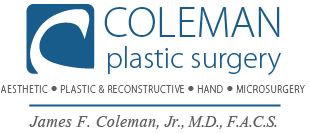Face Procedures
Facelift Surgery
What is facelift surgery?
Facelift (Rhytidectomy) is a surgical procedure performed to improve visible signs of aging in the face and neck, such as:
- Sagging in the midface
- Deep creases below the lower eyelids
- Deep creases along the nose extending to the corner of the mouth
- Fat that has fallen or is displaced
- Loss of muscle tone in the lower face that may create jowls
- Loose skin and excess fatty deposits under the chin and jaw that can make even a person of normal weight appear to have a double chin
A face lift is best performed on adult men and women who feel that their outward facial aging no longer reflects their personal view of themselves. Typically a face lift affords greater self-confidence and self-esteem.
Rejuvenation procedures typically performed in conjunction with a facelift are brow lift, to correct a sagging or deeply furrowed brow, and eyelid surgery to rejuvenate aging eyes.
What facelifts won't do
As a restorative surgery, a facelift does not change your fundamental appearance and cannot completely stop the aging process. You will continue to age naturally, but aging will progress from the more youthful version of yourself that has been restored by the facelift.
Is it right for me?
A facelift can only be performed surgically. Non-surgical rejuvenation treatments cannot achieve the same results, but may help delay the time at which a facelift becomes appropriate and complement the results of surgery. Facelift surgery is a highly individualized procedure and you should do it for yourself, not to fulfill someone else’s desires or to try to fit any sort of ideal image.
Facelift surgery is a good option for you if:
- You are physically healthy
- You do not smoke
- You have a positive outlook and specific, but realistic goals in mind for the improvement of your appearance
Where is it performed?
Facelift surgery can be performed on an out-patient basis or with an overnight stay for observation at a nearby fully accredited outpatient surgery center.
Anesthesia and Medication
A face lift does not always require general anesthesia (the patient is put to sleep). It depends in part on the amount of facial tissue to be treated and the anticipated length of surgery.
Recovery
Most patients recover well enough to return to work and most normal activities, including moderate exercise, in about 2 weeks.
Eyelid Surgery
What is eyelid surgery
Eyelid surgery (Blepharoplasty) improves the appearance of the upper eyelids, lower eyelids, or both. It gives a rejuvenated appearance to the surrounding area of your eyes, making you look more rested and alert.
Treatable conditions:
- Upper eyelid surgery can remove excess fatty deposits that appear as puffiness in the upper eyelids.
- Loose or sagging skin that creates folds or disturbs the natural contour of the upper eyelid, sometimes impairing vision, can be treated by eyelid lift surgery.
- Lower eyelid blepharoplasty can remove excess skin and fine wrinkles of the lower eyelid.
- Bags under the eyes can be corrected by blepharoplasty.
- Lower eyelid surgery can correct droopiness of the lower eyelids, showing white below the iris (colored portion of the eye).
Is it right for me?
Eyelid surgery is typically performed on adult men and women who have healthy facial tissue and muscles and have realistic goals for improvement of the upper and/or lower eyelids and surrounding area.
Good candidates for cosmetic eyelid surgery are:
- Healthy individuals who do not have a life-threatening illness or medical conditions that can impair healing
- Non-smokers
- Individuals with a positive outlook and specific goals in mind for blepharoplasty
- Individuals without serious eye conditions
You must tell your doctor if you have any of these medical conditions:
- Eye disease such as glaucoma, dry eye or a detached retina
- Thyroid disorders such as Graves’ disease and under or overactive thyroid
- Cardiovascular disease, high blood pressure or other circulatory disorders or diabetes
Where is it performed?
Eyelid is performed on an out-patient basis, at a nearby fully accredited outpatient surgery center.
Anesthesia and Medication
This procedure is typically performed under local anesthesia with sedation.
Recovery
Most patients recover well enough to return to the work and most normal activities, including vigorous exercise, in about 7 to 10 days.
Nose Surgery
Sometimes referred to as “nose reshaping” or a “nose job,” nose surgery (Rhinoplasty) improves the appearance and proportion of your nose, enhancing facial harmony and self confidence. Surgery of the nose may also correct impaired breathing caused by structural abnormalities in the nose.
Enhancing your appearance with nose plastic surgery
While the shape of your nose is usually the result of heredity, the appearance may have been altered in an injury or during prior surgery.
What can surgery of the nose accomplish?
Nose surgery can change:
- Nose size, in relation to the other facial structures
- Nose width, at the bridge
- Nose profile, with visible humps or depressions on the bridge
- Nasal tip, that is large or bulbous, drooping, or too upturned
- Nostrils that are large, wide or upturned
- Nasal asymmetry and deviation
Is it right for me?
Cosmetic nose surgery is a highly individualized procedure and you should do it for yourself, not to fulfill someone else’s desires or to try to fit any sort of ideal image.
A rhinoplasty procedure is a good option for you if:
- Your facial growth is complete and you are 16 years of age or older
- You are physically healthy
- You do not smoke
- You have specific, but realistic goals in mind for the improvement of your appearance
Where is it performed?
Nose surgery is performed on an out-patient basis, at a nearby fully accredited surgery center.
Anesthesia and Medication
This procedure is frequently performed under local anesthesia with sedation or general anesthesia.
Recovery
Most patients recover well enough to return to the work and most normal activities, including vigorous exercise, in about 7 to 10 days.
Brow lift
What is a brow lift?
Also referred to as a forehead lift, a brow lift
- minimizes the creases that develop across the forehead, or those that occur high on the bridge of the nose
- improves what are commonly referred to as frown lines
- repositions a low or sagging brow
Where is it performed?
Forehead surgery is performed at a nearby fully accredited surgery center.
Anesthesia and Medication
This procedure is frequently performed under local anesthesia with sedation or general anesthesia.
Recovery
Most patients recover well enough to return to the work and most normal activities, including vigorous exercise, in about 2 to 3 weeks.
Ear surgery
What is ear surgery?
Ear surgery (Otoplasty) improves the shape, position or proportion of the ear. It can correct a defect in the ear structure that is present at birth that becomes apparent with development or it can treat misshapen ears caused by injury.
Ear surgery creates a natural shape, while bringing balance and proportion to the ears and face. Correction of even minor deformities can have profound benefits to appearance and self-esteem.
Ear surgery is performed to treat:
- Overly large ears — a rare condition called macrotia
- Protruding ears occurring on one or both sides in varying degrees — not associated with hearing loss
- Adult dissatisfaction with previous ear surgery
Is it right for me?
Ear surgery is a highly individualized procedure and you should do it for yourself, not to fulfill someone else’s desires or to try to fit any sort of ideal image.
Children who are good candidates for ear surgery are:
- Healthy, without a life-threatening illness or untreated chronic ear infections
- Generally 7 years old, or when a child’s ear cartilage is stable enough for correction
- Cooperative and follow instructions well
- Able to communicate their feelings and do not voice objections when surgery is discussed
Teenagers and adults who are good candidates for ear surgery are:
- Healthy individuals who do not have a life-threatening illness or medical conditions that can impair healing
- Non-smokers
- Individuals with a positive outlook and specific goals in mind for ear surgery
Where is it performed?
Typically ear surgery is performed on an out-patient basis, either in Dr. Coleman’s office or in a nearby day-surgery center.
Anesthesia and Medication
This procedure is frequently performed under local or intravenous "twilight" anesthesia.
Recovery
Most patients recover well enough to return to the work and most normal activities, including vigorous exercise, in about 2 to 3 days.
Lip enhancement
What is lip enhancement?
As you age, your lips can become deflated and narrow, resulting in an artificial angry or aged appearance. Filling substances such as Juvederm, Restylane, or other facial fillers can be injected into the lips every 6 to 12 months to increase their size and eliminate fine lines.
A more permanent solution, but with a much longer recovery time, is a dermal graft, a procedure where a small amount of your own skin tissue is placed beneath the lip's covering to fill them out.
Where is it performed?
The procedure is performed on an out-patient basis, at a nearby fully accredited surgery center.
Anesthesia and Medication
This procedure is frequently performed under local or intravenous "twilight" anesthesia.
Recovery
Most patients recover well enough to return to the work and most normal activities, including moderate exercise, in about 5 to 10 days.
Chin enhancement
What is chin enhancement?
Chin surgery (mentoplasty) is a surgical procedure to reshape the chin either by enhancement with an implant or reduction surgery of the chin bone.
Many times a plastic surgeon may recommend chin surgery to a patient having nose surgery in order to achieve facial proportion, because the size of the chin may magnify or minimize the perceived size of the nose. Chin surgery helps provide a harmonious balance to your facial features so you feel better about your appearance.
Where is it performed?
The procedure is performed on an out-patient basis, at a nearby fully accredited surgery center.
Anesthesia and Medication
This procedure is frequently performed under local or intravenous "twilight" anesthesia.
Recovery
Most patients recover well enough to return to the work and most normal activities, including moderate exercise, in about 7 to 10 days.








